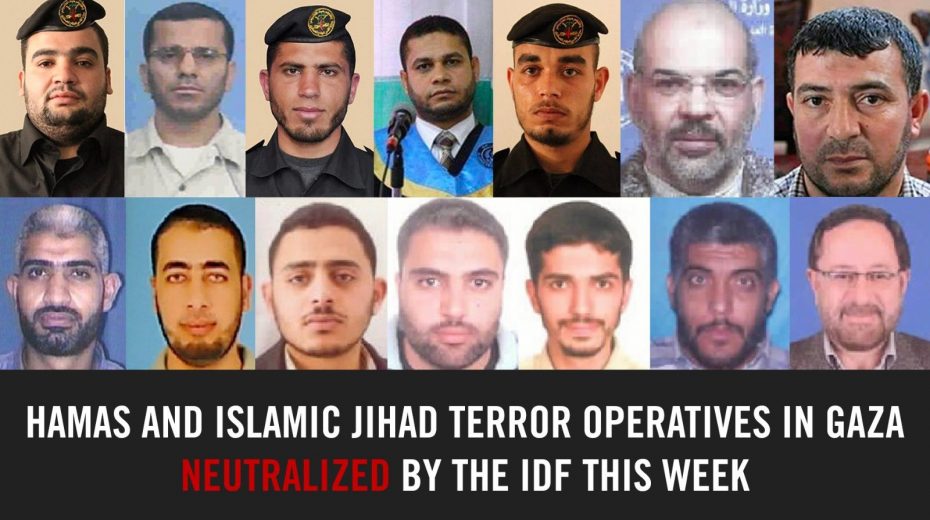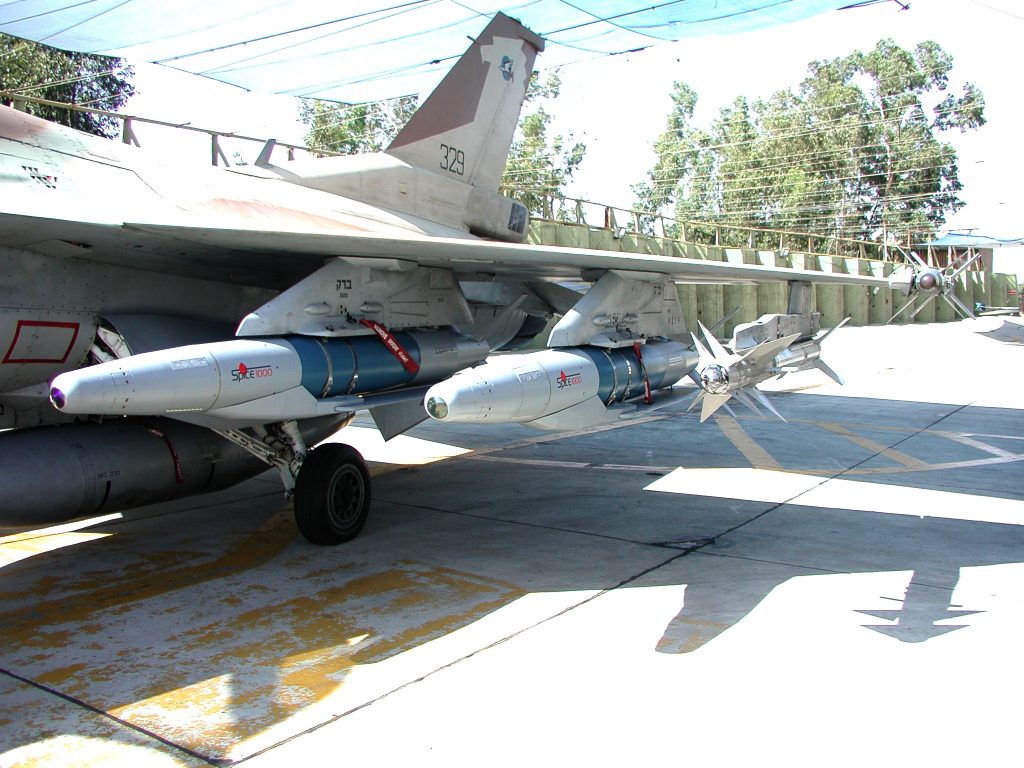Behind the Scenes: Why Gaza War was a Quick Win for Israel
Operation Breaking Dawn was the result of the gathering of intelligence about PIJ’s activities, a process that took months.
 Terror operatives neutralised by the IDF in Operation Breaking Dawn
Terror operatives neutralised by the IDF in Operation Breaking Dawn
Nearly five days after the end of Operation Breaking Dawn, the Israeli military operation against the Iranian-funded and trained Palestinian Islamic Jihad (PIJ) terror organization, life in Israel has resumed to ‘normal’.
However, that does not mean that the actions of the Israeli Defense Forces (IDF) against Palestinian terrorists are over.
Gaza and southern Israel may be quiet at the moment, but terror attacks are still taking place in Judea and Samaria while the other IDF operation ‘Wave Breaker’, started after a series of deadly terror attacks against civilians in Israeli cities earlier this year, continues unabated, as we shall see.
First, let’s take a look at new data released after the ceasefire went into effect on Sunday night. These data show that the IDF as well as other Israeli security and government bodies are constantly working to improve their modus operandi during the frequent mini-wars with the Palestinian terror organizations.
The same was now true for the disclosure of details about the operation which showed what exactly happened in Gaza before and after PIJ responded to Israel’s pre-emptive strike on Friday, August 5.
Operation Breaking Dawn was the result of the gathering of intelligence about PIJ’s activities, a process that took months.
During that intelligence operation, the phones of PIJ commanders were eavesdropped on, including those of PIJ leader Ziyad al-Nakhallah who operates from the PIJ headquarters in Beirut, Lebanon.
Millions of dollars demanded
Following the arrest of Bassam al-Saadi, the PIJ commander in Samaria and Judea, who was detained by IDF special forces in Jenin last Monday night, a new telephone conversation between PIJ commanders in Gaza and al-Nakhallah was tapped by Israeli intelligence.
During that phone call, PIJ commanders in Gaza angrily demanded millions of dollars from Iran to prepare an “appropriate response” to al-Saadi’s arrest.
Nakhallah was in Iran at the time meeting with leaders of the regime and the Islamic Revolutionary Guard Corps.
Apparently, Iran agreed to the Gaza commanders’ demand, as Israeli intelligence services subsequently discovered that PIJ in Gaza was preparing to carry out terrorist attacks against civilians and military personnel in Israel.
These involved sniper attacks and the launch of Kornet anti-tank missiles at Israeli vehicles in the Gaza border area.
The IDF brass and Prime Minister Yair Lapid, along with Defense Minister Benny Gantz, without consulting the security cabinet, finally decided on Friday afternoon to launch a pre-emptive strike against PIJ.
This happened after new intelligence showed that PIJ was about to carry out the aforementioned attacks and that one of the planned targets of those attacks was a passenger bus.
Operation Black Shash
The operation against the PIJ leaders in Gaza was dubbed “Black Shash” (Sha’at HaShin – D-day in English) and started at 16:15 last Friday.
The first attack took place in northern Gaza where Israeli Air Force (IAF) fighter jets killed PIJ commander Tayseer al-Jabiri in an apartment where he was hiding and from where he wanted to coordinate the new terrorist attacks on Israel.
The IAF used the new Spice missile from Rafael Industries, a precision weapon that prevents a building from collapsing after being hit.
 An Israeli F-16 armed with Spice missiles
An Israeli F-16 armed with Spice missiles
The missile hit an empty room above the apartment where al-Jabiri was staying and caused the floor to collapse killing the PIJ commander in his hide-out.
At the same time, an attack drone carried out the assassination of Abdallah Kadum who was the commander of the unit en route to carry out the Kornet attack. Kadum’s entire unit was subsequently also killed by IDF tanks and IAF fighters.
The entire top command of PIJ eliminated
Thus began Operation Breaking Dawn and shortly after, IAF aircraft destroyed PIJ’s 45 long-range rocket launchers and 17 observation posts along the Gaza border.
The destruction of the long-range missile launchers explains why, unlike the previous war last May, no long-range missile hit an Israeli city.
During that 11-day war, both Hamas and PIJ turned out to have GPS-guided precision missiles delivered to them by Iran.
Another IDF special unit, made up of exclusively female soldiers, operated a robotic rifle that later knocked out PIJ terrorists along the border with Israel.
On Saturday, Khaled Mansour, the only remaining PIJ top commander, was liquidated by the IAF, leaving the organization without a functioning central command.
Mansour was the PIJ commander for southern Gaza and was responsible, among other things, for the construction of attack tunnels underneath the Israeli border.
The Palestinian terror organization was now deprived of its entire top command infrastructure and as a result, after intense pressure from Egyptian mediators and Hamas leaders, agreed to a ceasefire.
Civilian casualties
Another aspect that stood out as different from all previous wars with the Palestinian terror groups in Gaza was the very low number of Palestinian civilians killed by the IDF and by IAF attacks in the densely populated areas in the coastal enclave.
It is now known that at least 15 Palestinian civilians were killed by PIJ missiles, while 11 others were killed in Israeli actions against PIJ.
This relatively low number was partly due to the efforts of operators of Israel’s internal security service Shin Beth who were calling Palestinian civilians prior to a bombing raid ordering them to leave the building they were residing within ten minutes.
For example, I listened to an audio recording of a Shin Beth employee making two calls to a Palestinian citizen in Gaza.
The second time, the operator asks four times whether the Palestinian Arab is sure that everyone has left the building and also the buildings behind the building in question.
The Shin Beth agent then says that he sees the building (via a camera from a drone) and is still not sure that everyone has left the area after which the Palestinian Arab replies that he is now sure that the evacuation has been completed. Only then was the IAF strike approved by the war room overseeing the fighting
Improved provision of crucial information
Then there is the improvement in what is called “Hasbara” in Israel, the provision of information to the outside world during war or other cases of crisis in Israel.
Under the leadership of Prime Minister Yair Lapid, who himself worked for a long time in the media, there is finally an improvement in Israel’s handling of this aspect of warfare.
Lapid personally asked the foreign media for honest reporting based on the facts while his spokeswoman Keren Hajioff gave reporters information about Israel’s actions in real-time.
In addition, the IDF was also quick to respond to developing blood libels about the killing of Palestinian children in Gaza this time around.
For example, it was alleged that the IAF was responsible for an incident in Jabalyah that killed four children.
Only a few minutes after the first report about the tragedy the Israeli military declared that no actions had been taken in the refugee camp at the time the children were killed while some minutes later, a video was published by the IDF showing that a PIJ missile was responsible for the deaths of the children.
In the days after the ceasefire began, more videos were released of PIJ rockets exploding and killing victims inside Gaza.
In fact, it can be said that Israel was now releasing information in real-time, including that about the specific actions that were carried out against PIJ.
Aftermath
In Gaza, meanwhile, efforts are underway to normalize daily life and to make that happen, Israel has reopened the border crossings for the delivery of goods and the supply of fuel to the only electricity grid in the Hamas-controlled enclave.
The 14,000 Palestinian Arabs who worked in Israel before the war are forced to stay at home for the time being with negotiations underway to lift the withdrawal of work permits as soon as possible.
Operation Wave Breaker
Then there is the other IDF operation ‘Wave Breaker’, which is still ongoing and is taking place in Judea and Samaria.
Nightly IDF operations were once again carried out there against individual terrorists virtually every night this week.
In the city of Shechem (Nablus in Arabic), for example, a long-sought terrorist was killed last Tuesday during an IDF operation.
This happened after a gunfight broke out between IDF soldiers from special units and Palestinian terrorists who wanted to prevent the arrest of Ibrahim al-Nabulsi who was, among other things, involved in terrorist attacks on religious Jews who wanted to visit Joseph’s grave in Shechem in order to pray there.
IDF Chief of Staff Aviv Kochavi and Prime Minister Lapid said on Wednesday that the fight against Palestinian terrorists in Judea and Samaria will continue unabated.
In addition to shooting attacks and attacks with boulders and rocks, there are increasing attacks in which a Palestinian terrorist uses his car in order to kill Israelis.
Operation Wave Breaker was launched in May after a series of deadly terrorist attacks against Israeli civilians in several cities across the Jewish state and initially focused on the town of Jenin in northern Samaria, a PIJ-controlled hotbed of terror.
IDF operations against PIJ and lately also the PA-affiliated Al-Aqsa Brigades were later widened to other areas controlled by the Palestinian Authority.
1 comment:
Damn, I feel so bad for those poor terrorists. They no longer have anybody to direct mentally disabled young people how to wear and detonate suicide vests. Whatever will they do for personal fulfillment?
Post a Comment